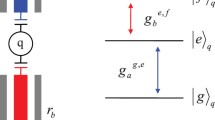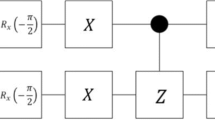Abstract
We present an efficient scheme for the generation of NOON states of photons in circuit QED assisted by a superconducting charge qutrit. It is completed with two kinds of manipulations, that is, the resonant operation on the qutrit and the resonator, and the single-qubit operation on the qutrit, and they both are high-fidelity operations. Compared with the one by a superconducting transmon qutrit proposed by Su et al. (Sci Rep 4:3898, 2014), our scheme does not require to maintain the qutrit in the third excited state with a long time, which relaxes the difficulty of its implementation in experiment. Moreover, the level anharmonicity of a charge qutrit is larger and it is better for us to tune the different transitions of the charge qutrit resonant to the resonator, which makes our scheme faster than others.

Similar content being viewed by others
References
Nielsen MA, Chuang IL (2000) Quantum computation and quantum information. Cambridge University Press, Cambridge
Ren BC, Deng FG (2013) Hyperentanglement purification and concentration assisted by diamond NV centers inside photonic crystal cavities. Laser Phys Lett 10:115201
Ren BC, Deng FG (2014) Hyper-parallel photonic quantum computation with coupled quantum dots. Sci Rep 4:4623
Wang YH, Song HS (2009) Preparation of multi-atom specially entangled W-class state and splitting quantum information. Chin Sci Bull 54:2599–2605
Long GL, Xiao L (2004) Parallel quantum computing in a single ensemble quantum computer. Phys Rev A 69:052303
Long GL, Xiao L (2003) Experimental realization of a fetching algorithm in a 7-qubit NMR spin Liouville space computer. J Chem Phys 119:8473–8481
Feng GR, Xu GF, Long GL (2013) Experimental realization of nonadiabatic holonomic quantum computation. Phys Rev Lett 110:190501
Hu CY, Young A, O’Brien JL et al (2008) Giant optical Faraday rotation induced by a single-electron spin in a quantum dot: applications to entangling remote spins via a single photon. Phys Rev B 78:085307
Bonato C, Haupt F, Oemrawsingh SSR et al (2010) CNOT and Bell-state analysis in the weak-coupling cavity QED regime. Phys Rev Lett 104:160503
Wei HR, Deng FG (2013) Universal quantum gates for hybrid systems assisted by quantum dots inside doublesided optical microcavities. Phys Rev A 87:022305
Wang TJ, Song SY, Long GL (2012) Quantum repeater based on spatial entanglement of photons and quantum-dot spins in optical microcavities. Phys Rev A 85:062311
Wang C (2012) Efficient entanglement concentration for partially entangled electrons using a quantum-dot and microcavity coupled system. Phys Rev A 86:012323
Sheng YB, Zhou L, Wang L et al (2013) Efficient entanglement concentration for quantum dot and optical microcavities systems. Quant Inform Proc 12:1885–1895
Togan E, Chu Y, Trifonov AS et al (2010) Quantum entanglement between an optical photon and a solid-state spin qubit. Nature 466:730–734
Neumann P, Kolesov R, Naydenov B et al (2010) Quantum register based on coupled electron spins in a room-temperature solid. Nat Phys 6:249–253
Wei HR, Deng FG (2013) Compact quantum gates on electron-spin qubits assisted by diamond nitrogen-vacancy centers inside cavities. Phys Rev A 88:042323
Chen Q, Yang WL, Feng M et al (2011) Entangling separate nitrogen-vacancy centers in a scalable fashion via coupling to microtoroidal resonators. Phys Rev A 83:054305
Zheng AS, Li JH, Yu R et al (2012) Generation of Greenberger-Horne-Zeilinger state of distant diamond nitrogen-vacancy centers via nanocavity input-output process. Opt Express 20:16902
Yang WL, Yin ZQ, Xu ZY et al (2010) One-step implementation of multiqubit conditional phase gating with nitrogen-vacancy centers coupled to a high-\(Q\) silica microsphere cavity. Appl Phys Lett 96:241113
Knill E, Laflamme R, Milburn GJ (2001) A scheme for efficient quantum computation with linear optics. Nature 409:46–52
Nemoto K, Munro WJ (2004) Nearly deterministic linear optical controlled-not gate. Phys Rev Lett 93:250502
Lin Q, Li J (2009) Quantum control gates with weak cross-Kerr nonlinearity. Phys Rev A 79:022301
Beenakker CWJ, DiVincenzo DP, Emary C et al (2004) Charge detection enables free-electron quantum computation. Phys Rev Lett 93:020501
Ren BC, Wei HR, Deng FG (2013) Deterministic photonic spatial-polarization hyper-controlled-not gate assisted by quantum dot inside one-side optical microcavity. Laser Phys Lett 10:095202
Wallraff A, Schuster DI, Blais A et al (2004) Strong coupling of a single photon to a superconducting qubit using circuit quantum electrodynamics. Nature 431:162–67
Liu YX, You JQ, Wei LF et al (2005) Optical selection rules and phase-dependent adiabatic state control in a superconducting quantum circuit. Phys Rev Lett 95:087001
Wang YD, Xue F, Song Z et al (2007) Detection mechanism for quantum phase transition in superconducting qubit array. Phys Rev B 76:174519
Cao Y, Huo WY, Ai Q et al (2011) Theory of degenerate three-wave mixing using circuit QED in solid-state circuits. Phys Rev A 84:053846
Huo WY, Long GL (2008) Entanglement and squeezing in solid-state circuits. New J Phys 10:013026
Gao GL, Cai GC, Huang SS et al (2012) 1\(\rightarrow \)N quantum controlled phase gate realized in a circuit QED system. Sci China Phys Mech Astron 55:1422–1426
Wang H, Sun HC, Zhang J et al (2012) Transparency and amplification in a hybrid system of the mechanical resonator and circuit QED. Sci China Phys Mech Astron 55:2264–2272
Qian Y, Zhang YQ, Xu JB (2012) Amplifying stationary quantum discord and entanglement between a superconducting qubit and a data bus by time-dependent electromagnetic field. Chin Sci Bull 57:1637–1642
Zhang SL, Zhang GF, Wang YL et al (2013) A novel superconducting quantum interference device for biomagnetic measurements. Chin Sci Bull 58:2917–2919
Li HJ, Wang YW, Wei LF et al (2013) Experimental demonstrations of high-\(Q\) superconducting coplanar waveguide resonators. Chin Sci Bull 58:2413–2417
Yu LB, Tong NH, Xue ZY et al (2012) Simulation of the spin-boson model with superconducting phase qubit coupled to a transmission line. Sci China Phys Mech Astron 55:1557–1561
Lucero E, Barends R, Chen Y et al (2012) Computing prime factors with a Josephson phase qubit quantum processor. Nat Phys 8:719–723
Blais A, Huang RS, Wallraff A et al (2004) Cavity quantum electrodynamics for superconducting electrical circuits: an architecture for quantum computation. Phys Rev A 69:062320
You JQ, Nori F (2011) Atomic physics and quantum optics using superconducting circuits. Nature 474:589–597
Rigetti C, Gambetta JM, Poletto S et al (2012) Superconducting qubit in a waveguide cavity with a coherence time approaching 0.1 ms. Phys Rev B 86:100506
DiCarlo L, Chow JM, Gambetta JM et al (2009) Demonstration of two-qubit algorithms with a superconducting quantum processor. Nature 460:240–244
Reed MD, DiCarlo L, Nigg SE et al (2012) Realization of three-qubit quantum error correction with superconducting circuits. Nature 482:382–385
Reagor M, Paik H, Catelani G et al (2013) Reaching 10 ms single photon lifetimes for superconducting aluminum cavities. Appl Phys Lett 102:192604
Schuster DI, Houck AA, Schreier JA et al (2007) Resolving photon number states in a superconducting circuit. Nature 445:515–518
Johnson BR, Reed MD, Houck AA et al (2010) Quantum non-demolition detection of single microwave photons in a circuit. Nat Phys 6:663–667
Strauch FW, Jacobs K, Simmonds RW et al (2010) Arbitrary control of entanglement between two superconducting resonators. Phys Rev Lett 105:050501
Strauch FW (2012) All-resonant control of superconducting resonators. Phys Rev Lett 109:210501
Hua M, Deng FG (2013) Selective-resonance-based quantum entangling operation on qubits in circuit QED. arXiv:1310.0102
Zhou L, Sheng YB, Cheng WW et al (2013) Efficient entanglement concentration for arbitrary less-entangled NOON states. Quantum Inf Process 12:1307–1320
Merkel ST, Wilhelm FK (2010) Generation and detection of NOON states in superconducting circuits. New J Phys 12:093036
Wang H, Mariantoni M, Bialczak RC et al (2011) Deterministic entanglement of photons in two superconducting microwave resonators. Phys Rev Lett 106:060401
Su QP, Yang CP, Zheng SB (2014) Fast and simple scheme for generating NOON states of photons in circuit QED. Sci Rep 4:3898
Sandberg M, Wilson CM, Persson F et al (2008) Tuning the field in a microwave resonator faster than the photon lifetime. Appl Phys Lett 92:203501
Allman MS, Altomare F, Whittaker JD et al (2010) rf-SQUID-mediated coherent tunable coupling between a superconducting phase qubit and a lumped-element resonator. Phys Rev Lett 104:177004
Bialczak RC, Ansmann M, Hofheinz M et al (2011) Fast tunable coupler for superconducting qubits. Phys Rev Lett 106:060501
Haack G, Helmer F, Mariantoni M et al (2010) Resonant quantum gates in circuit quantum electrodynamics. Phys Rev B 82:024514
Acknowledgments
This work was supported by the National Natural Science Foundation of China (11174039) and NECT-11-0031.
Author information
Authors and Affiliations
Corresponding author
About this article
Cite this article
Hua, M., Tao, MJ. & Deng, FG. Efficient generation of NOON states on two microwave-photon resonators. Chin. Sci. Bull. 59, 2829–2834 (2014). https://doi.org/10.1007/s11434-014-0443-y
Received:
Accepted:
Published:
Issue Date:
DOI: https://doi.org/10.1007/s11434-014-0443-y




